- Home
- Shelby Foote
The Civil War: A Narrative: Volume 2: Fredericksburg to Meridian Page 51
The Civil War: A Narrative: Volume 2: Fredericksburg to Meridian Read online
Page 51
Either place would afford refuge for his saddle-weary troopers if all went as he hoped and planned, but he knew well enough that the most dangerous part of the long ride lay before him. By now, doubtless, every grayback in the state would have learned of the presence of his two regiments at Newton Station two days ago, with the result that a considerable number of them must be hot on his trail or lying in wait for him in all directions. However, this had its compensations as well as its drawbacks. Scarcely less important than the temporary severing of Vicksburg’s main supply line was the disruption of its defenses, preventing the hasty concentration of its outlying forces against Grant in the early stages of his river crossing. In point of fact, Grierson was more successful in this regard than he had any way of knowing. Orders flew thick and fast from Pemberton’s headquarters in the Mississippi capital, directing all units within possible reach to concentrate on the capture of the ubiquitous blue column. An infantry brigade, en route from Alabama to reinforce Vicksburg, was halted at Meridian to protect that vital intersection of the Southern Railroad and the Mobile & Ohio, while another moved east from Jackson in the direction of the break at Newton Station. Forces at Panola and Canton, under James Chalmers and Lloyd Tilghman, were shifted to Okolona and Carthage to block the northern escape route. All of these troops, amounting to no less than a full division, not counting the various home-guard units caught up in the swirl, were thus effectively taken out of the play and removed from possible use at this critical time against either Grant or Grierson, who were off in the opposite corner of the map. Not that Pemberton was neglecting matters in that direction, at least so far as Grierson was concerned. Detachments of fast-riding cavalry were ordered eastward from Port Hudson and Port Gibson—the latter a scant half dozen miles from Grant’s intended point of landing at Grand Gulf—in case the marauders tried for a getaway to the south or the southwest. In short, Pemberton’s reaction to the widespread confusion in his rear and along his lines of supply and communication, while altogether commendable from a limited point of view, amounted to full co-operation with the raiders in the accomplishment of their secondary mission, which was to divert his attention, as well as his reserves, away from the point at which Grant was preparing to hurl two thirds of the blue army.
Grierson wasted no time. Monday, April 27—Grant’s birthday; Sherman prepared for his feint up the Yazoo, and McClernand was told to get his troops aboard the transports at Hard Times—the blue riders pushed westward across Pearl River, aided considerably by the capture of a ferryboat by scouts who masqueraded as Confederates. While the crossing was in progress the company detached five days ago near Starkville rejoined the main body, reporting that in addition to throwing a scare into the defenders of Macon, as instructed, it had also made a feint at Enterprise, twelve miles below Meridian, thus adding to the difficulties of the rebel high command’s attempt to pinpoint the location of the invaders. Safely across the Pearl, the reunited 1000-man column pressed on west to Hazlehurst, where a string of boxcars was set afire on a siding of the New Orleans, Jackson & Great Northern Railroad. Flames spreading to a nearby block of buildings, the erstwhile incendiaries turned firemen and worked side by side with the citizens in preventing the loss of the whole town. At dusk, in a driving rain which had helped to contain the fire, the colonel ordered his troopers to remount. The march was west; Grand Gulf was only forty miles away and he hoped to make it there tomorrow, in case Grant had crossed the Mississippi. However, morning brought no indication that any part of the Army of the Tennessee was on this side of the river, so Grierson veered a bit to the south for Natchez, his alternate sanctuary, which was only twenty miles farther away than Grand Gulf. But that too was not to be. Beyond Union Church that afternoon, the raiders were enjoying a rest halt when they were charged by what one of them called “a crowd of graylooking horsemen galloping and shooting in a cloud of dust and smoke.” The result at first was panic and the beginning of a rout, but presently they stiffened and repulsed the attackers, who turned out to be nothing more than a couple of understrength companies on the prowl. The colonel prepared to push on next day to Natchez, but was warned that night by one of the Butternut Guerillas, who had ridden ahead and struck up a conversation with a rebel outpost group, that seven companies of cavalry from Grand Gulf were planning to ambush him when he moved westward in the morning. So Grierson once more changed his plans, abandoning Natchez as his destination. Determined now to press on down to Baton Rouge, though this added another hundred miles to the distance his weary men would have to ride, he turned back east at dawn of April 29, avoiding the ambush laid so carefully in what was now his rear.
By early afternoon they were in Brookhaven, twenty-five miles east, astride the railroad they had crossed two days ago, twenty miles to the north, when the march was west. “There was much running and yelling” on the part of the startled citizens, Grierson later reported, “but it soon quieted into almost a welcome.” Here, as at Hazlehurst on Monday, sparks from the burning railroad station and another string of boxcars set a section of the town ablaze, and the troopers once more turned firemen to help the natives keep the flames from spreading. Meantime, however, a wrecking crew kept busy tearing up track and burning crossties, thus abolishing the possibility of a locomotive pursuit by troops from Jackson. Back in the saddle, the raiders moved south along the railroad and made camp that night, eight miles below Brookhaven and just over a hundred miles from Baton Rouge. At Summit before sundown of the last day of April, the colonel spared the depot lest his men have to turn firefighters again to save the town, but there was another unfortunate—or fortunate, depending on the point of view—encounter with rebel spirits when the troopers uncovered a cache of rum in fifty-gallon barrels. Grierson broke up the binge, got the revelers mounted at last, drunk or sober, and pressed on south another half dozen miles before stopping for the night. Dawn of May Day completed two full weeks the men had spent in the saddle, with only a half day’s rest aside from the minimal halts for sleep and food. Once more the march was west. “A straight line for Baton Rouge, and let speed be our safety,” Grierson told his officers as the column was put in motion.
Speed there was—the raiders covered no less than seventy-five miles of road in the following twenty-eight hours—but there was fighting, too, the first and only serious opposition the main body encountered in the course of the long raid. Even so, it was not much. At Wall’s Bridge, which spanned the Tickfaw River just north of the Louisiana line, three companies of Confederates from Port Hudson laid a noonday ambush that cost the leading Union company eight casualties. Grierson promptly brought his artillery to the front, shelled the opposite bank, and ordered a charge that not only cleared the bridge but threw the rebels into headlong flight. Riding south all night, with no time out for rest or food, the blue column reached and crossed the Amite River, the last unfordable stream this side of Baton Rouge, before the aroused graybacks could bar the way. Six miles short of the Louisiana capital next morning, his troopers reeling in their saddles from lack of sleep, Grierson called a halt at last. The men tumbled from their mounts and slept where they fell, along the roadside, but the colonel himself, as befitted a former music teacher with an ingrained mistrust of horses, was refreshing himself by playing the piano in the parlor of a nearby plantation house when a picket burst in with news that they were about to be overwhelmed and captured. A rebel force was approaching from the west, he said, with skirmishers out! Grierson, knowing better, rode out to meet the reported enemy, who turned out to be members of the garrison at Baton Rouge, sent to investigate an improbable-sounding rumor “that a brigade of cavalry from General Grant’s army had cut their way through the heart of the rebel country, and were then only five miles outside the city.” Somewhat restored by their naps, the men remounted and rode into the capital that afternoon. Cheered by spectators, civilians as well as soldiers, the two-mile-long procession of road-worn men and animals, so weathered and dust-caked that they could scarcely be distinguished from the
prisoners and Negroes they had gathered along the way, wound slowly around the public square, then south out of town to a grove of magnolias two miles south, where they dismounted, unsaddled, and fell so soundly asleep that they could not be aroused to accept hot coffee.
They had cause for weariness, having covered more than six hundred miles in less than sixteen days, and for thankfulness as well: thankfulness that Pemberton had lost Van Dorn to Bragg three months before, along with nearly all his cavalry, and that it was Abel Streight and not themselves who had been made the prime concern of Bedford Forrest. Streight had left Fort Henry on the day they left La Grange, and was surrendering in East Alabama while Grierson’s men, having caught up on their sleep at last, were enjoying their first midday meal in the magnolia grove just south of the Louisiana capital. Different circumstances might well have led to different results, including perhaps a reversal of their current roles as prisoners on the one hand and heroes on the other, but the fact remained that the Illinois troopers had dealt with conditions as they found them. And having done so, they had cause for pride. At a total cost of barely two dozen casualties—“3 killed, 7 wounded, 5 left on the route sick … and 9 men missing, supposed to have straggled”—they had “killed and wounded about one hundred of the enemy, captured and paroled over 500 prisoners, many of them officers, destroyed between fifty and sixty miles of railroad and telegraph, captured and destroyed over 3000 stand of arms, and other army stores and government property to an immense amount.” So Grierson later reported, adding as if by afterthought, despite his continued mistrust of all equine creatures: “We also captured 1000 horses and mules.”
Within three days the colonel was on a steamboat for New Orleans, where he was feted and presented with a horse by the admiring citizenry. “My dear Alice,” he wrote his wife that night, “I like Byron have had to wake up one morning and find myself famous. Since I have been here it has been one continuous ovation.” In early June, with his picture on the covers of both Harper’s Weekly and Leslie’s Illustrated, he was promoted to brigadier general. But perhaps the finest tribute of all came from a man by no means given to using superlatives, on or off the record. Assessing the value of the raid in its relation to the over-all campaign for the taking of Vicksburg, of which it was very much a part, Grant said flatly: “It was Grierson who first set the example of what might be done in the interior of the enemy’s country without any base from which to draw supplies.”
For the present, however, Grant at Hard Times had no more knowledge of Grierson’s progress, across the way, than Grierson had had of Grant’s while riding west from Hazlehurst. All the cavalryman learned for certain as he pressed on toward the river was that the army had not crossed as planned, which meant that something must have gone awry. Something had indeed. When the raiders turned back east from Union Church at dawn of April 29, avoiding the ambush laid in what had been their front, they missed hearing the guns of the attackers and defenders at Grand Gulf, less than thirty air-line miles away. It was just as well, for otherwise they might have been lured into what would have been a trap. Except for the rather negative advantage of proving that this was no place to attempt an east-bank landing, the attack was an utter failure, and an expensive one at that.
Porter’s doubts had been increasing all week, ever since his April 22 reconnaissance of the stronghold on the bluff across the way. Though he had kept up a show of confidence in his talks with Grant, privately he was airing his misgivings in dispatches to his Washington superiors, not only by way of preparing them for bad news, but also by way of divesting himself in advance of any responsibility for the failure he saw looming. “I am quite depressed with this adventure,” he wrote Fox, “which as you know never met with my approval.” This last was something less than strictly true, though when he signaled the flotilla captains to move against Grand Gulf at 8 o’clock next morning, April 29, his forebodings soon turned out to have been well founded. The navy’s task was to silence the rebel batteries, then cover the crossing by the transports bringing the army over to take the place by storm; but when four of the seven ironclads closed to within pistol shot of the 75-foot bluff—so at least it seemed to Grant, who watched the contest from aboard a tug—they were severely mauled. The flagship Benton took 70 hits, the Tuscumbia 81; the Lafayette took 45, the Pittsburg 35. The other three boats, Carondelet, Mound City, and Louisville, all veterans of the river war from its beginning, did their fighting at long range, lobbing shells into the blufftop works, and consequently suffered little damage. Even so, when Porter hoisted the pennant for the flotilla to drop back out of action at 12.30—all but the Tuscumbia, which had been struck in her machinery and swept powerless downstream until she fetched up short against the Louisiana bank—a total of 75 casualties, including 18 dead, had been subtracted from its crews. By contrast, although time would disclose that they had lost 3 killed and 15 wounded, the defenders seemed unhurt behind their earthwork fortifications. Grand Gulf was as much a failure for the Union navy as Fort Donelson had been, just over a year ago. Porter frankly admitted as much. A crossing might be managed elsewhere, he told Grant, but not here, under the muzzles of those guns across the way.
Grant had not expected a repulse, but he was prepared for what he considered the outside chance of one. Now that a repulse had been encountered, an alternate plan was put into execution without delay. McClernand’s men would debark at Hard Times, march south across the point of land to De Shroon’s, a plantation landing some four miles downstream, and be ready before dawn to get back aboard the transports, which were to steal past Grand Gulf under cover of darkness, hugging the western bank while the gunboats re-engaged the batteries. All this went as planned, afloat and ashore. The navy lost only one man in its renewal of the duel with the blufftop cannoneers, and the army made its night march unobserved, to find the transports waiting unscathed in the predawn darkness at De Shroon’s. “By the time it was light,” Grant later wrote, “the enemy saw our whole fleet, ironclads, gunboats, river steamers, and barges, quietly moving down the river three miles below them, black, or rather blue, with National troops.”
Accomplishing this he showed the flexibility that would characterize his planning throughout the various stages of the campaign which now was under way in earnest. Other characteristics he also showed. An officer was to remember seeing the general sitting his horse beside the road at a point where a narrow bridge had been thrown across a bog. “Push right along, men,” he told the marchers, speaking in almost a conversational tone. “Close up fast and hurry over.” The soldiers recognized him and were obviously pleased to see their commander sharing their exertions, but the officer noted that their only reply was to do as he directed. They did not cheer him; they just “hurried over.” It was as if, in the course of the long winter of repeated failures, they had caught his quality of quiet confidence. Charles Dana, for one, had begun to think so. He had come down here three weeks ago to report on Grant’s alleged bad habits. So far, though, he not only had detected none of these; he had never even heard him curse or seen him lose his temper. Dana was puzzled. “His equanimity was becoming a curious spectacle to me,” the former journalist later recalled. Tonight, for example, riding beside the general along the dark road from Hard Times to De Shroon’s, he saw Grant’s horse stumble. “Now he will swear,” he thought, half expecting to see the rider go tumbling over the animal’s head; “For an instant his moral status was on trial.” But Grant lost neither his balance nor his temper. “Pulling up his horse, he rode on, and, to my utter amazement, without a word or sign of impatience.”
Nor did the night march across the point of land, from Hard Times to De Shroon’s, put an end to the need for sudden improvisation. Having bypassed Grand Gulf—which he could not allow to remain alive for long, so close in his rear—Grant still was faced with the problem of where to effect a landing on the Mississippi bank, in order to return for a strike at the fortified bluff from its vulnerable landward flank. A look at the map suggested Rodney,
another twelve miles downstream. But that would not only give the troops a considerable distance to march, and the defenders time to improve their position and call in reinforcements, it would also place the bluecoats on the far side of Bayou Pierre, which would have to be crossed when they turned back north. Yet to make a landing short of the point where the bayou flowed westward into the river, five miles below, might be to founder the army in some unmapped and unsuspected swamp. What was needed was a guide, a sympathetic native of the region, and Grant sent a detachment of soldiers across the river in a skiff, with instructions to bring back what he wanted. They returned before midnight with an east-bank slave who filled the bill. At first he had been unwilling to come, and in fact had had to be taken by force, but now that he found himself in the lamp-lighted headquarters tent, facing the Union commander across an unrolled chart, he turned co-operative. “Look here,” Grant said. “Tell me where this road leads to—starting where you see my finger here on the map and running down that way.” The Negro studied the problem, then shook his head. “That road fetches up at Bayou Pierre,” he said. “But you can’t go that way, ’cause it’s plum full of backwater.” The thing to do, he replied to further questions, was to go ashore at Bruinsburg, six miles below De Shroon’s. This would still be south of Bayou Pierre, but at least it was only half as far as Rodney. Moreover, there was a good road leading from there to Grand Gulf by way of Port Gibson, which lay ten miles inland, well back from the trackless swamps and canebrakes of the river bottoms. At Bruinsburg, the captive slave explained, “you can leave the boats and the men can walk on high ground all the way. The best houses and plantations in all the country are there, sir, all along that road.”

 Chickamauga and Other Civil War Stories
Chickamauga and Other Civil War Stories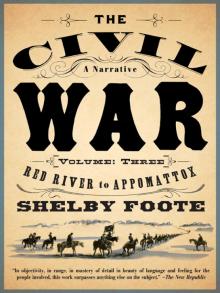 The Civil War: A Narrative: Volume 3: Red River to Appomattox
The Civil War: A Narrative: Volume 3: Red River to Appomattox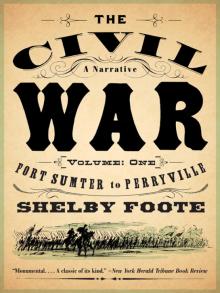 The Civil War: A Narrative: Volume 1: Fort Sumter to Perryville
The Civil War: A Narrative: Volume 1: Fort Sumter to Perryville Jordan County
Jordan County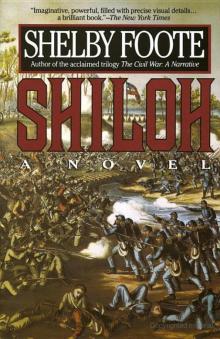 Shiloh
Shiloh Love in a Dry Season
Love in a Dry Season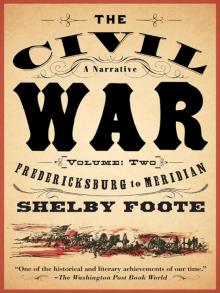 The Civil War: A Narrative: Volume 2: Fredericksburg to Meridian
The Civil War: A Narrative: Volume 2: Fredericksburg to Meridian Chickamauga
Chickamauga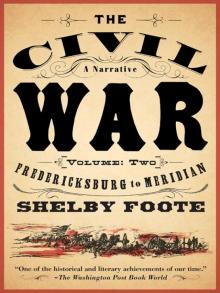 The Civil War: A Narrative: Fredericksburg to Meridian
The Civil War: A Narrative: Fredericksburg to Meridian